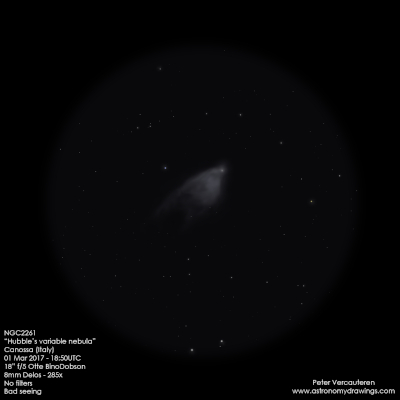Hubble's Nebula
Hubble's Nebula

William Herschel discovered NGC 2261 = H IV-2 = h399 on 26 Oct 1783 (very early sweep 67) and recorded "a curious nebula of a fan shape." His summary description (based on 4 observations) reads "cB, fan-shaped, about 2' long from the centre." His placed it in class IV, which includes planetary nebulae. John Herschel reported on 8 Jan 1828 (sweep 118), "*12m with bright cometic branch 60" l whose axis is 60° np. The star is a little ill-defined. The apex of the neb comex exactly up to star, but does not pass it."
Lord Rosse and/or assistant George Johnstone Stoney first observed NGC 2261 on 22 Dec 1848 and again on 11 Feb 1849. Rosse or Stoney sketched the nebula on 16 Jan 1850 (plate XXXVII, figure 10) and noted "two comparatively dark spaces, one near the vertex and other near the base of the cone." William Lassell observed and sketched NGC 2261 in March 1853 with his 24-inch equatorial reflector from Malta. He noted, "the nucleus not stellar, but like the nucleus of the nebula in Andromeda [M31]." Father Angelo Secchi published a detailed sketch and description in 1856 using the 9.6" refractor in Rome.
Julius Schmidt discovered the variability of R Mon in 1861 with a 6" refractor. While a graduate student at Yerkes Observatory in 1916, Hubble discovered the nebula itself was variable, hence the popular nickname. A series of photographs chronically the changes were taken with the 30" Reynolds reflector between 1916-1920 at the Helwan Observatory in Egypt. This is an unusual bipolar nebula with the second southern jet hidden from view. According to the California Institute of Technology, Hubble's Variable Nebula was the first object photographed through the 200-inch Hale telescope at Palomar Observatory. Hubble sat in the prime focus cage of that instrument and recorded an image on 26 Jan 1949.
200/250mm - 8" (1/28/84): comet-like nebula extends from R Mon.
300/350mm - 13.1" (1/28/84): Hubble's Variable Nebula is bright, small, fan-shaped 2:1 N-S and widest at the north boundary. The nebulosity tapers down towards 12th magnitude R Monocerotis at the south tip which appears to have a very small high surface brightness halo. The western edge (oriented NW-SE) is slightly weaker and more curved than the eastern edge which is sharper and straighter N-S. This is an impressive nebula with high surface brightness and interesting structure.
400/500mm - 18" (3/4/08): Hubble's variable nebula is a striking fan-shaped object, with a mag 12 "star" at its south tip with the nebula extending to the north. The fan displays a great deal of variation in brightness and structure at 300x. The brightest portion is on the northwest side of the fan, though it dims a little near the tip on the west side. The eastern rim is bright and sharply defined N-S like a thin finger. The nebulosity dims along the northern end of the fan and a small, wedge-shaped darker area extends into the fan from the north.
900/1200mm - 48" (5/1/19): at 375x; the view through this scope showed a great deal of structure and brightness variations. I was struck by the length of the eastern edge, which dimmed after the bright thin section extending north, but could be traced just beyond two mag 17-17.5 stars, for a total length of 3'.
Notes by Steve Gottlieb